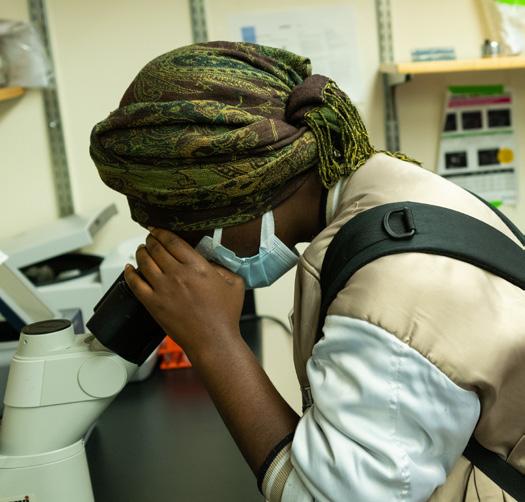











It was an eventful year for the University of Vermont Cancer Center across each of our four pillars: research, community outreach, education, and clinical care.
Fundamental laboratory and population-based research contributed to numerous high impact publications and was supported with over $14 million from the National Institutes of Health and other national organizations. Cancer Center members shared recent accomplishments at our first scientific retreat, where they voted to award pilot grant funding for an inter-programmatic project on “spatialomics and precision pipeline,” an initiative geared toward uncovering novel agents to treat cancer.
Our mission to reduce the burden of cancer would not be possible without the input of stakeholders who participate as members of our Community Advisory Board. This group informs initiatives that will most significantly benefit our community. Two such efforts were a lung cancer screening collaboration with Dartmouth Cancer Center and Vermonters Taking Action Against Cancer, and the Women’s Health and Cancer Conference, now supported by a $1 million endowment from the Courtney and Victoria Buffum Family Foundation.
We continue to invest in new educational programs including our first-annual “high school career day,” hosting over 100 local students to learn about career paths in the biomedical sciences, and the Clinical Investigator Development Initiative program, supported by the J. Walter Juckett Foundation, that provides grant funding to two clinicians.
Our robust cancer practice saw over 32,000 patient visits this year and continued to provide novel options for patients, including offering over one hundred clinical trials and access to integrative oncology approaches such as acupuncture, meditation, and health coaching.
It’s been quite a year, and I am grateful for the researchers, clinicians, staff, community supporters, and patients who are leading our quest to reduce the burden of cancer in Vermont and northern New York.
Sincerely,
Randall F. Holcombe, M.D., M.B.A.
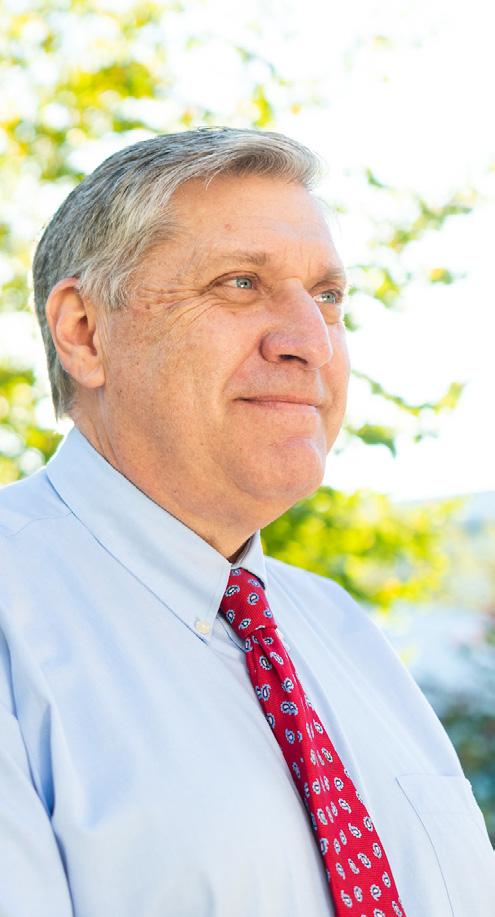 J. Walter Juckett Chair in Cancer Research Professor of Medicine, Larner College of Medicine Director, University of Vermont Cancer Center Chief, Division of Hematology & Oncology
J. Walter Juckett Chair in Cancer Research Professor of Medicine, Larner College of Medicine Director, University of Vermont Cancer Center Chief, Division of Hematology & Oncology
UVMHN ALICE HYDE MEDICAL CENTER
UVMHN CHAMPLAIN VALLEY PHYSICIANS HOSPITAL
UVMHN VNA CHITTENDEN GRAND ISLE
UVMHN UVM MEDICAL CENTER
UVMHN ELIZABETHTOWN COMMUNITY HOSPITAL
UVMHN CENTRAL VERMONT MEDICAL CENTER
UVMHN PORTER MEDICAL CENTER
UVMHN INTERLAKES HEALTH
HUDSON HEADWATERS HEALTH NETWORK
UVM Cancer Center (UVMCC) serves patients across Vermont and six counties of northern New York.
NUMBER OF MEMBERS: 172
NUMBER OF ACTIVE PATIENTS: 11,155
GRANT DOLLARS: $13,011,759
NUMBER OF CLINICAL TRIALS: 104
NUMBER OF ANNUAL PATIENT VISITS:
32,413
NUMBER OF PATIENTS ENROLLED ON A CLINICAL TRIAL:
672 NUMBER OF PUBLICATIONS: 87
Our comprehensive research program includes basic laboratory studies on the mechanisms of cancer development: how genetic mutations drive cancer formation, for instance, or how complex tumor environments promote cancer growth and allow cancers to evade anti-cancer drugs. It also encompasses population-based studies exploring areas like the environmental factors leading to the development of cancer, how best to detect cancer early when it can be most easily cured, and how to advance the treatment of patients through clinical trials. Our 172 members drive progress toward these goals.
This year, the UVM Cancer Center welcomed these talented investigators to its membership:
ELIAS KLEMPERER, PH.D. CANCER POPULATION SCIENCE, FULL MEMBER [1]

Improving strategies and testing interventions to reduce combusted tobacco use via tobacco control interventions and tobacco regulatory science.
ERIC THRAILKILL, PH.D. CANCER POPULATION SCIENCE, FULL MEMBER [2]
Targeting novel decision-making factors for intervention to reduce risk for combusted tobacco use and other cancer-risk behaviors.
JONATHAN BOYSON, PH.D. CANCER HOST AND ENVIRONMENT, FULL MEMBER
Focusing on T-cell biology, especially those cells (e.g. gamma delta T-cells) that play critical roles in tumor immunology, infectious disease, and autoimmunity. [photo page 4]
MANSOUR GERGI, M.D., FULL MEMBER [3]
Exploring cardiovascular care in cancer patients and evaluating bleeding as a complication of antithrombotic use in cancer patients.
ELISE TARBI, PH.D. CANCER POPULATION SCIENCE, ASSOCIATE MEMBER [4]

Understanding and improving serious illness communication so that patients with advanced cancer and their families feel seen and heard.
VITOR MORI, PH.D., TRAINEE [5]


Vermont Lung Center (VLC); Focusing on mathematical and computational models of the respiratory system.
KATHLEEN QUINN, TRAINEE
Ph.D. candidate in Cellular, Molecular, and Biomedical Sciences, Frietze Lab; Researching epigenetic regulation in breast cancer.

Dr Holmes’ new grant focuses on a novel platelet receptor potentially associated with an increased risk for thrombosis and cancer patients.
One in five patients with cancer will develop a blood clot that interferes with optimal cancer treatment and can lead to early death. Predicting who will get a blood clot is the focus of an R21 grant from the National Cancer Institute received by UVM Cancer Center member Chris Holmes, M.D., Ph.D.
Focused on a new biomarker found on circulating platelets in the body, this protein, called FcɣRIIa, has been associated with increased blood clotting in patients with cardiovascular disease.
Working in collaboration with David Schneider, M.D. (Cardiology), Holmes and her team will study over 500 patients at the UVM Cancer Center with the goal of identifying patients who may develop blood clots during their cancer treatment to allow prevention of this complication of cancer and its therapies.



Grant funding: $2,569,545
Program Themes
• Biology and Mechanisms of Cancer and its Microenvironment
• Cancer Immunology, Stem Cells, and Vascularization
• Cancer Therapeutics and Supportive Care
Jonathan Boyson, Ph.D. Dr. Boyson received an R21 grant from the National Institute of Allergy and Infectious Disease to study how a group of proteins called SLAM family receptors regulate gamma delta T cells.

Gamma-delta (gd) T cells represent a small percentage of T cells in the body but they are an important part of our immune response in the lung, gut, and skin. Most gd T cells are programmed during development to secrete either interferon-gamma (IFN-g) or interleukin-17 (IL-17). IFN-g-producing gd T cells have potent anti-tumor activity while IL-17producing gd T cells can actually promote tumor growth and metastasis.
Understanding how to regulate the balance between these two types of gd T cells may lead to new immune-based treatments for cancer patients. Dr. Boyson studies a group of proteins called SLAM family receptors which seem to regulate this balance. In this project funded by the National Institute of Allergy and Infectious Disease, Dr. Boyson uses a novel laboratory technique called single-cell proteogenomics to interrogate how SLAM proteins regulate gd T cells, with the ultimate goal of applying this knowledge toward the future use of gd T cells in cancer therapy.

PROGRAM CO-LEADERS: MAIJA REBLIN, PH.D.,(LEFT) ASSOCIATE PROFESSOR, LARNER COLLEGE OF MEDICINE, AND BRIAN SPRAGUE, PH.D., (RIGHT) PROFESSOR, LARNER COLLEGE OF MEDICINE AND DIRECTOR OF THE VERMONT BREAST CANCER SURVEILLANCE SYSTEM
SPOTLIGHT: HIGH-IMPACT PUBLICATIONS
Nancy Gell, Ph.D., M.P.H. Associate Professor, College of Nursing and Health Sciences

Grant funding: $6,299,728
Program Themes
• Reducing tobacco use in vulnerable populations and providing evidence to guide tobacco policy.
• Evaluating and developing cancer screening strategies that maximize benefits while minimizing harms.
• Developing behavioral interventions to improve the health and quality of life of those at risk for cancer, cancer survivors, and their caregivers.
Director, Vermont Centeron Behavior and Health
Publication: Journal of the National Cancer Institute
Smoking is a leading cause of premature death and health inequities in the United States. Although about half of adult smokers made past-year quit attempts from 2014 to 2019, only 7.5% reported sustained cessation, and most who made quit attempts did not report using cessation treatments.
This study shows that sociodemographic inequalities in cessation were pervasive and not entirely correspondent with sociodemographic variation in motivation to quit. Further, this paper illustrates that encouraging quit attempts and equitable access to smoking cessation aids are public health priorities.
Publication: Journal of Cancer Survivorship
Exercise can help manage chemotherapy side effects, reduce rates of depression, and even make treatment more effective.
Dr. Gell, along with UVM Cancer Center member Kim Dittus, M.D., Ph.D., and Kushang Patel, Ph.D., M.P.H., at the University of Washington enrolled 39 rural cancer survivors over the age of 60 in a study to pilot test remoteenhance fitness for rural, older cancer survivors.
The study demonstrates that tele-fitness is feasible and initial findings show improvements in physical function and physical activity. Participants improved 23% on a sit-to-stand test, a common way to measure physical function, and reported a 33% increase in step counts as compared to a control group.
Brian Sprague, Ph.D. Professor, Larner College of Medicine

Green and Gold Professorship in Surgical Research
Publication: Journal of the American Medical Association
3D mammography screening can reduce the false positive rate for all women and provide a reduction in late-stage breast cancer for the small group of women with dense breasts and high breast cancer risk.
The first of its size, the findings suggest that women with dense breasts and high breast cancer risk should be offered 3D screening to reduce their risk of a late-stage diagnosis, and all women and healthcare providers should be aware of the benefit of reduced false positive rates with 3D screening.
Grant funding: $3,832,334
Program Themes
• Epigenetics
• Molecular mechanisms of hematological malignancies
• Mechanisms of breast cancer progression and breast cancer treatment response
• DNA damage and repair and its role in carcinogenesis
• Redox signaling in the pathology and therapy of disease


University Distinguished Professor Yvonne JanssenHeininger, Ph.D., professor of pathology and laboratory medicine, is an expert in redox medicine, which specializes in developing new compounds to regulate oxidation reactions. While oxygen is critical for the chemical reactions our cells need to survive, some oxygen reactions occur at the wrong locations or in the wrong proteins, which can cause damage leading to illness and death. The Janssen-Heininger lab team has discovered new tools for determining oxidation targets, designing precise small molecules to treat lung fibrosis and cancer.
Along with UVM Cancer Center member Albert van der Vliet, Ph.D., Janssen-Heininger co-founded the internationally recognized Redox Biology and Pathology Program at UVM. She is a fellow of the Society for Redox Biology and Medicine and a member of the UVM Cancer Center and the Vermont Lung Center. She recently received a Lung Cancer Discovery Award from the American Lung Association (ALA) to study protein oxidation in the development of lung cancer with the aim of creating a new druggable target for chemotherapy-resistant tumors.

“ While avoiding surgery is already a recent game-changer for rectal cancer patients, the NOM-ERA study brings patient-centered care to a whole new level by dropping six weeks of daily radiation down to
UVM CANCER CENTER IS ADVANCING THE STANDARD OF CARE
Starting in 2015, rectal cancer patients treated at the University of Vermont Cancer Center (UVMCC) had access to a groundbreaking clinical trial allowing them to avoid the typically standard surgery if their tumor was found to go away completely after a combination chemotherapy and radiation. Led locally by colorectal surgeon Peter Cataldo, M.D., study results published this past year demonstrated that over 50% of patients were able to avoid surgery removing their rectum if they received 6 weeks of radiation and chemotherapy plus additional chemotherapy. Because of the dramatic improvement in quality of life for these patients, this approach is the new standard of care at UVMCC. While avoiding surgery is one of the most significant advances in rectal cancer in decades, six weeks of daily radiation is still a significant burden on patients and their families.
Now, research is swinging the pendulum further towards patient quality of life. UVMCC is one of four clinical sites investigating a course of treatment condensing the typical six-week therapy down to one week. One week of radiation had been found to provide equivalent cancer control and quality of life outcomes at Washington University in St. Louis. Researchers hypothesize that in this larger cohort over half of patients will have their cancer completely go away following completion of therapy while maintaining a good quality of life, similar to what is seen with six weeks of radiation.
The study, called Non-Operative Management and Early Response Assessment in Rectal Cancer (NOMERA), was created by Dr. Hyun Kim at Washington University. Local principal investigator Dr. Anker was instrumental in bringing the patient-focused study to UVMCC and in helping with the final trial design. Additional supporting UVMCC members include radiation oncologist Dr. Nat Lester-Coll, colorectal surgeons Drs. Peter Cataldo, Jesse Moore, Krista Evans, and Jeremy Dressler, and medical oncologists Drs. Steven Ades, Randall Holcombe, Molly Barry, Marc Greenblatt, and Sarah Gillett.
Dr. Anker has established a national reputation for his expertise in treating rectal cancer with a non-operative approach. Outside of Washington University, UVMCC has had the highest number of patients enroll on the trial. While every patient enrolled in the study will have access to the shortened one week of therapy, if the results prove promising the next step will be a major randomized national trial comparing the two approaches.
Patrick Austin, one of the participants on the study whose tumor resolved completely following radiation and chemo, said of the trial: “I would participate in this course of treatment again without hesitation. The time commitment was easy at one week only; side effects were minimal as they did not build upon each other as treatment proceeded.”
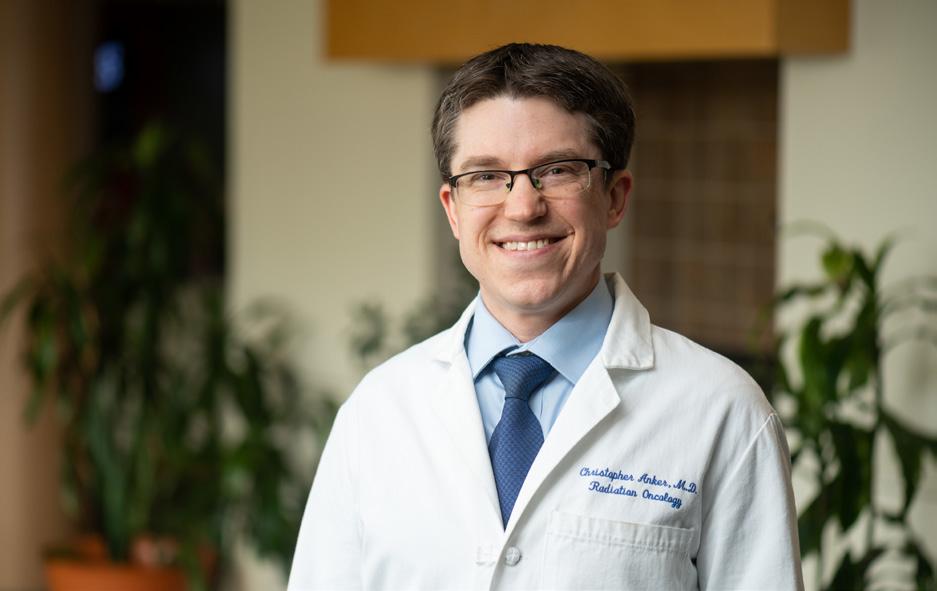
just one.”
The University of Vermont Athletics Department continues its effort to raise awareness for cancer research through its annual “Rally Against Cancer” games presented by Mascoma Bank. Fans are encouraged to come cheer on the UVM Catamounts and wear lavender to raise awareness for all cancer types.
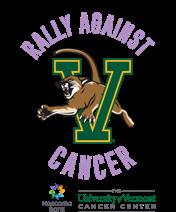
RANDALL HOLCOMBE, M.D. AND OLIVIA WHITE
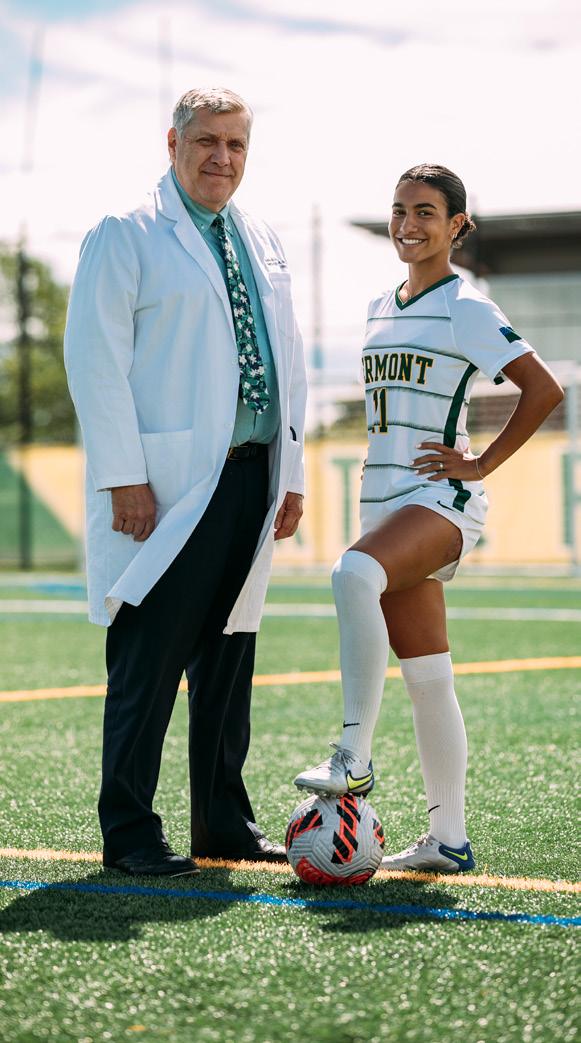
Vermont has a higher than average incident rate of melanoma, and the UVM Cancer Center community outreach team is spreading the word about sun safety.
SUN SAFETY ON SITE: UVM Cancer Center Director Randall F. Holcombe, M.D., M.B.A., visited the PC Construction crew who worked on building the Firestone Medical Research Building to say ‘thanks’ for their work and distribute sunscreen, popsicles, and information about sun safety.

SUNSCREEN FOR MARATHONERS: The UVM Cancer Center Community Outreach team handed out sunscreen and chatted with marathon runners and their supporters about sun safety ahead of the Vermont City Marathon, an annual marathon in the city of Burlington, VT that brings together more than 7,500 runners, 20,000 spectators, and 1,700 volunteers over Memorial Day Weekend.
The Burlington-based hat-maker Skida is giving warmth and comfort to cancer patients around the country through the Skida [+1] program. For every alpine or nordic hat purchased using the Skida [+1] promotional code, the company donates one hat to the customer’s corresponding regional cancer center. Cancer patient Christina Loren, pictured, benefited from the program. She loves her new hat, she says, which she wears indoors and out. Use promo code “UVMCC” to give [+1] to the UVM Cancer Center.

SAVE THE DATE: SEPTEMBER 29, 2023
The University of Vermont Cancer Center’s annual Women’s Health and Cancer Conference celebrated its 25th year in 2022. This free, educational event is aimed at empowering and supporting individuals and communities with knowledge about cancer prevention, detection, treatment, and survivorship. Participants—including clinicians, patients, and community members—come together to:



• Access the latest, evidence-based information about cancer prevention and detection;
• Learn about treatment options across a range of cancer types;
• Gain information about support and wellness options to enhance survivorship;
• Feel inspired and supported.
In 2022, the Courtney and Victoria Buffum Family Foundation gave $1 million to create the Patti O’Brien, M.D. Women’s Health and Cancer Fund, which will support the conference into the future.

Anational cancer research event called Convergence brought experts from around the country and the world to the University of Vermont October 24-27 to discuss interdisciplinary techniques to advance cancer treatment. The experts, along with UVM Cancer Center faculty, presented information about their cutting-edge cancer research.
The conference was co-hosted by the UVM Cancer Center and the National Science Foundation-sponsored Cancer Convergence Education Network.
As part of the UVM activities, 100 students from local high schools attended a half-day “Careers in Cancer” event. The high school students broke into small groups and interacted with world-renowned scientists to learn about career pathways in cancer research. The students also visited UVM labs to meet with a range of faculty, see science in action, and view demonstrations.
The demonstrations included growing and visualizing crystals to understand protein structure, microscopy to visualize the important components of a dividing cell, and exploring the various equipment needed to successfully carry out cancer research.

Students from Burlington High School, Burlington Technical Center, South Burlington High School, Winooski High School, Essex High School, and Champlain Valley Union (CVU) High School attended the event.


“ The Convergence conference is about the future of cancer research.”
– Randall Holcombe, M.D., M.B.A.
The new Clinician Investigator Development Initiative (CIDI) is designed to encourage productivity and career development for clinician investigators at the UVM Cancer Center.
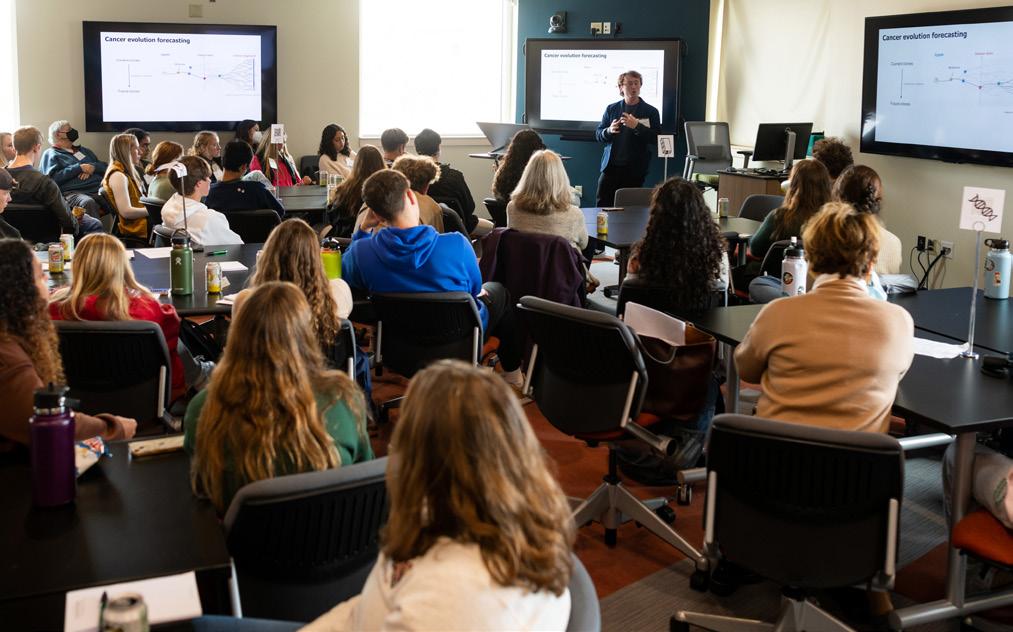
“Clinical research is valuable and possible when investigators are given protected time, mentorship, and resources to dive into scholarly activity,” said Randall Holcombe, M.D., M.B.A., director of the UVM Cancer Center.
As part of this initiative, the Cancer Center recently selected its inaugural Juckett Scholar recipients, Kara Landry, M.D., and Alissa Thomas, M.D., who will each receive approximately $250,000 over two years with an eye towards creating new standards for cancer care delivery. The awards are supported by the Juckett Foundation, which has provided decades of support to the UVM Cancer Center, helping to improve cancer outcomes for patients across Vermont and Northern New York.

CAR T-CELL THERAPY WILL BE AVAILABLE TO PATIENTS AT THE UVM MEDICAL CENTER, BEGINNING IN FEBRUARY 2023
The University of Vermont Cancer Center will offer a novel, highly effective form of cancer treatment called CAR T-cell therapy beginning in February of 2023. The Cancer Center will be the only health care institution in Vermont and northern New York to provide the treatment.
CART, as it is known, uses the body’s immune system to fight cancer. Unlike other immunotherapies, CART uses genetically modified T cells from the patient to attack cancer cells.
Approved by the FDA in 2017 for a variety of blood cancers, CAR T-cell therapy induces a “complete response”—where no remaining cancer is visible— in 50-80% of patients treated with it, depending on the cancer type, including in 70% of patients with mantle cell lymphoma and 80% with follicular lymphoma. Up to 90% of patients with these two cancers see at least a partial response, where the cancer has been significantly diminished. The therapy is typically used after other forms of treatment have been unsuccessful.
Though long-term data for CAR T-cell therapy is not yet available, the treatment has the potential to cure cancer. Of the first patients treated over 10 years ago with CAR T-cell therapy on clinical trials, few of those who achieved a complete response have seen their cancer return.
The Cancer Center’s new CART program will be led by James Gerson, M.D., who came to UVM from the University of Pennsylvania, where CAR T-cell therapy was discovered and developed.
Gerson worked directly with the team of researchers who created the therapy, led by Carl H. June, M.D., and was among the first clinicians to use it in a commercial setting.
“We are thrilled to have someone with Dr. Gerson’s expertise directing our CART clinic and offering this life-saving therapy to patients in our region,” said Randall Holcombe, M.D., M.B.A., director of the UVM Cancer Center.
Currently, patients in UVM’s catchment area who want CART therapy need to travel, usually to Boston, New York, or Rochester, to access it.
The remote treatment can cause significant upheaval in their lives, Gerson said, since it requires multiple episodes of care over the course of three to six months. Many patients live in the city where they’re being treated for four weeks.
“Our goal is for patients to be able to access this therapy without uprooting their lives,” he said.
CART works by training T cells—a type of white blood cell used by the immune system to kill viruses and other foreign bodies—to recognize and attack cancer cells. The treatment has multiple steps. First, T cells are removed from the patient’s blood. Then, in the lab, they’re modified by adding a receptor gene— a “chimeric antigen receptor” or CAR—that can recognize a protein on the cancer cell, latch onto it and kill the cell. Finally, cells are multiplied and given back to the patient.
At present, CART is effective only for blood cancers: lymphoma, some leukemias, and multiple myeloma. Research is ongoing to apply the method to other cancers.
A new form of immunotherapy
CAR T-cell therapy is a new form of immunotherapy utilizing T cells. In other immunotherapies, patients are given a medication that prevents proteins in the immune system called checkpoints from disabling T cells, allowing them to kill cancer cells.
“Checkpoint inhibitors,” as the class of medications is known, work well for melanoma, lung and some other cancers but aren’t effective for blood cancers.
CART has some advantages over the therapy. Checkpoint inhibitors don’t have the curative potential that CART appears to have. “The therapy could make a significant difference for patients in Vermont and New York,” Holcombe said.

“ We look forward to bringing this innovative new treatment to the many patients who need it in our region. I’ve seen first-hand its potential to save lives.” – James Gerson, M.D.
MADE POSSIBLE BY PHILANTHROPY, THE UVM CANCER CENTER IS PLANNING A MOBILE CANCER EDUCATION AND SCREENING VEHICLE TO REACH RURAL COMMUNITIES

Survival rates improve when cancer is detected early, but for many of our rural neighbors regular cancer screenings are out of reach.
Identifying pathways for improved cancer screening and care for rural neighbors is a multi-tiered, crossdepartmental priority for the UVM Cancer Center. In an effort to bridge theory and practice, cancer survivor Jan Blomstrann has made a gift through the Trout Lily Foundation to the Cancer Center to support the design and launch of a mobile outreach vehicle—a resource that’s proven effective in improving health care utilization in rural areas elsewhere in the country.
The new vehicle will enable clinicians to conduct skin checks to detect potential abnormalities, blood analyses for genetic screening and research, and share education materials to empower patients in their health maintenance. Cuttingedge camera technology will provide a real-time link to cancer experts at the hospital while body composition devices and other equipment will readily evaluate other known factors that predispose people to cancer. The vehicle will deliver information to help people today while generating data to benefit future generations through cancer research.
THE BUTLER FAMILY FOUNDATION FUND FOR CANCER RESEARCH SUPPORTS THE CUNNIFF LAB IN EFFORT TO DISCOVER AND ADVANCE TREATMENTS FOR MALIGNANT MESOTHELIOMA
The Cunniff Lab, led by cancer center member Brian Cunniff, Ph.D., has received funding from the newly established Butler Family Foundation Fund for Cancer Research at the University of Vermont Cancer Center to support research focused on malignant mesothelioma. Mesothelioma is a rare cancer that affects the lining of the lungs or abdomen of people typically exposed to asbestos fibers. In rare instances this deadly disease is hereditary in nature. The Butler Fund was established by the Butler family in memory of two loved ones lost to mesothelioma.

The Cunniff Lab, in collaboration with RS Oncology, LLC, a biopharmaceutical company based in Cambridge, Massachusetts, has been working on the development of a novel drug known as RSO-021 for malignant mesothelioma and other diseases. RS Oncology is currently treating patients with RSO-021 as part of its ongoing Phase 1/2 MITOPE clinical trial in the United Kingdom.
The new funding from the Butler Family will support work in the Cunniff Lab focused on identifying signature biomarkers most responsive to this new treatment.
GAS FOR GRAMMY: GROWING UP, JENELLE HARDY KNEW CANCER. A CLOSE FAMILY FRIEND HAD BATTLED THE DISEASE FOR YEARS, MAKING TRIPS TO BOSTON EVERY MONTH FOR TREATMENT.
After her grandmother, Deborah, was diagnosed with lung cancer in 2020 and had to make those same trips, the financial truth of being treated in a city 250 miles away hit home for Jenelle, then an 11th grader at Bellows Free Academy in St. Albans, Vermont. When Deborah passed away in March of 2022, Jenelle was heartbroken. Troubled by the income disparity that made the treatment her family could afford inaccessible to so many others, she decided to launch a campaign raising money for gas cards for cancer patients.
“Both of us posted on Facebook, and then friends shared and their friends shared, and in the end we raised over $3,100,” Jenelle’s mother, Jenifer said. “Gas for Grammy,” as they called the program, was born. The Hardys donated the funds to the UVM Cancer Center, which used them to the purchase 126 $25 gas cards, distributing them to cancer patients in the hematology/oncology and radiation clinics. Most were gone within weeks.
“ We can’t take away the cancer, but if we can take away the anxiety or the stress or even one little piece of their worry, that makes it all worth it.”
– Jenelle Hardy
ANNUAL IMPACTS
$65 MILLION $19.9 MILLION $3.2 MILLION
20212030 VALUE IMPACTS
2021-2030
$596.2 MILLION $192.3 MILLION $22.5 MILLION
THE UVM CANCER CENTER GENERATES $93.6 million OF ECONOMIC IMPACT ANNUALLY, SUPPORTING OVER 250 jobs.
OVER THE NEXT 10 YEARS, THE CUMULATIVE ECONOMIC IMPACT OF THE UVM CANCER CENTER ON THE LOCAL AND REGIONAL ECONOMY IS PROJECTED TO BE $847 million.
FORECASTED OVER A 10-YEAR PERIOD
$383.2 THOUSAND $3.9 MILLION
$5.2 MILLION $32.1 MILLION
UVMCC IS VERMONT’S ONLY NOT-FOR-PROFIT COMPREHENSIVE CLINICAL AND RESEARCH CANCER CENTER.
266 EMPLOYEES IN 2021 8,800+ PATIENTS SERVED IN 2021
TOTAL BENEFIT
$93.6 MILLION $847 MILLION
TOTAL BENEFIT 1974 FOUNDED MORE THAN 50 YEARS AGO 60 STUDENTS SERVED ANNUALLY
Data and assumptions used in the study are based on several sources, including data from UVMCC, industry and employment data from the U.S. Bureau of Labor Statistics and U.S. Census Bureau, and outputs of Lightcast’s Multi-Regional Social Accounting Matrix model. The study applies a conservative methodology and follows standard practice using only the most recognized indicators of economic impact. For a description of the data and approach used in the study, please contact UVMCC for a copy of the full report.
University of Vermont Cancer Center
89 Beaumont Ave.
Burlington, VT 05405
www.vermontcancer.org

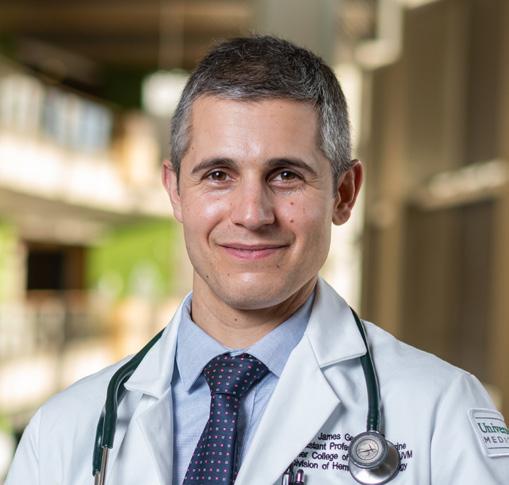
cancer@uvmcc.med.uvm.edu
@UVMcancercenter
@UVMCancerCenter
